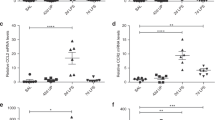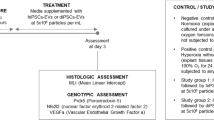Abstract
Purpose
Pulmonary hypoplasia secondary to congenital diaphragmatic hernia (CDH) is characterized by impaired epithelial homeostasis. Recently, amniotic fluid stem cells (AFSCs) have been shown to promote growth in hypoplastic lungs of rat fetuses with CDH. Herein, we investigated whether CDH hypoplastic lungs mount an endoplasmic reticulum (ER) stress response and whether AFSCs could re-establish pulmonary epithelial homeostasis.
Methods
Primary epithelial cells were isolated from fetal rat lungs at E14.5 from control and nitrofen-exposed dams at E9.5. Nitrofen-exposed epithelial cells were grown in medium alone or co-cultured with AFSCs. Epithelial cell cultures were compared for apoptosis (TUNEL), cytotoxicity (LIVE/DEAD assay), proliferation (5′EdU), and ER stress (CHOP, Bcl-2) using one-way ANOVA (Dunn’s post-test).
Results
Compared to control, nitrofen-exposed epithelial cells had increased cytotoxicity and apoptosis, reduced proliferation, and activated ER stress. AFSCs restored apoptosis, proliferation, and ER stress back to control levels, and significantly reduced cytotoxicity.
Conclusions
This study shows for the first time that ER stress-induced apoptosis is activated in the pulmonary epithelium of hypoplastic lungs from fetuses with CDH. AFSC treatment restores epithelial cellular homeostasis by attenuating the ER stress response and apoptosis, by increasing proliferation and migration ability, and by reducing cytotoxicity.


Similar content being viewed by others
References
Balayla J, Abenhaim HA (2014) Incidence, predictors and outcomes of congenital diaphragmatic hernia: a population-based study of 32 million births in the United States. J Matern Fetal Neonatal Med 27:1438–1444. https://doi.org/10.3109/14767058.2013.858691
Burgos CM, Frenckner B (2017) Addressing the hidden mortality in CDH: A population-based study. J Pediatr Surg 52:522–525. https://doi.org/10.1016/j.jpedsurg.2016.09.061
Cauley RP, Stoffan A, Potanos K et al (2013) Pulmonary support on Day 30 as a predictor of morbidity and mortality in congenital diaphragmatic hernia. J Pediatr Surg 48:1183–1189. https://doi.org/10.1016/j.jpedsurg.2013.03.012
Hislop A, Reid L (1976) Persistent hypoplasia of the lung after repair of congenital diaphragmatic hernia. Thorax 31:450–455. https://doi.org/10.1136/thx.31.4.450
Keijzer R, Liu J, Deimling J et al (2000) Dual-hit hypothesis explains pulmonary hypoplasia in the nitrofen model of congenital diaphragmatic hernia. Am J Pathol 156:1299–1306. https://doi.org/10.1016/S0002-9440(10)65000-6
Van Loenhout RB, Tseu I, Fox EK et al (2012) The pulmonary mesenchymal tissue layer is defective in an in vitro recombinant model of nitrofen-induced lung hypoplasia. Am J Pathol 180:48–60. https://doi.org/10.1016/j.ajpath.2011.09.032
Sano R, Reed JC (2013) ER stress-induced cell death mechanisms. Biochim Biophys Acta 1833:3460–3470. https://doi.org/10.1016/j.bbamcr.2013.06.028
Xu C, Bailly-Maitre B, Reed JC (2005) Endoplasmic reticulum stress: cell life and death decisions. J Clin Invest 115:2656–2664. https://doi.org/10.1172/JCI26373
Lu HY, Zhang J, Wang QX et al (2015) Activation of the endoplasmic reticulum stress pathway involving CHOP in the lungs of rats with hyperoxia-induced bronchopulmonary dysplasia. Mol Med Rep 12:4494–4500. https://doi.org/10.3892/mmr.2015.3979
Teng RJ, Jing X, Michalkiewicz T et al (2017) Attenuation of endoplasmic reticulum stress by caffeine ameliorates hyperoxia-induced lung injury. Am J of Physiol Lung Cell Mol Physiol 312:L586–L598. https://doi.org/10.1152/ajplung.00405.2016
Dekoninck P, Toelen J, Roubliova X et al (2015) The use of human amniotic fluid stem cells as an adjunct to promote pulmonary development in a rabbit model for congenital diaphragmatic hernia. Prenat Diagn 35:833–840. https://doi.org/10.1002/pd.4621
Di Bernardo J, Maiden MM, Hershenson MB, Kunisaki SM (2014) Amniotic fluid derived mesenchymal stromal cells augment fetal lung growth in a nitrofen explant model. J Pediatr Surg 49:859–864. https://doi.org/10.1016/j.jpedsurg.2014.01.013
Pederiva F, Ghionzoli M, Pierro A et al (2013) Amniotic fluid stem cells rescue both in vitro and in vivo growth, innervation, and motility in nitrofen-exposed hypoplastic rat lungs through paracrine effects. Cell Transplant 22:1683–1694. https://doi.org/10.3727/096368912X657756
Carraro G, Perin L, Sedrakyan S et al (2008) Human amniotic fluid stem cells can integrate and differentiate into epithelial lung lineages. Stem Cells 26:2902–2911. https://doi.org/10.1634/stemcells.2008-0090
Garcia O, Carraro G, Turcatel G et al (2013) Amniotic fluid stem cells inhibit the progression of bleomycin-induced pulmonary fibrosis via CCL2 modulation in bronchoalveolar lavage. PLoS One 13:e71679. https://doi.org/10.1371/journal.pone.0071679
Buckley S, Shi W, Carraro G et al (2011) The milieu of damaged alveolar epithelial type 2 cells stimulates alveolar wound repair by endogenous and exogenous progenitors. Am J Respir Cell Mol Biol 45:1212–1221. https://doi.org/10.1165/rcmb.2010-0325OC
Caniggia I, Tseu I, Han RN et al (1991) Spatial and temporal differences in fibroblast behavior in fetal rat lung. Am J Physiol 261:L424–L433. https://doi.org/10.1152/ajplung.1991.261.6.L424
Jesudason EC, Connell MG, Fenig DG et al (2000) Cell proliferation and apoptosis in experimental lung hypoplasia. J Pediatr Surg 35:129–133. https://doi.org/10.1016/S0022-3468(00)80029-9
Keijzer R, Van Tuyl M, Tibboel D (2000) Hormonal modulation of fetal pulmonary development: relevance for the fetus with diaphragmatic hernia. Eur J Obstet Gynecol Reprod Biol 92:127–133. https://doi.org/10.1016/S0301-2115(00)00436-X
Chinoy MR, Chi X, Cilley RE (2001) Down-regulation of regulatory proteins for differentiation and proliferation in murine fetal hypoplastic lungs: Altered mesenchymal–epithelial interactions. Pediatr Pulmonol 32:129–141. https://doi.org/10.1002/ppul.1099
Kling DE, Aidlen JT, Fisher JC et al (2005) Nitrofen induces a redox-dependent apoptosis associated with increased p38 activity in P19 teratocarcinoma cells. Toxicol In Vitro 19:1–10. https://doi.org/10.1016/j.tiv.2004.04.010
Aidlen JT, Nazarey PP, Kinane TB et al (2007) Retinoic acid-mediated differentiation protects against nitrofen-induced apoptosis. Birth Defects Res B Dev Reprod Toxicol 80:406–416. https://doi.org/10.1002/bdrb.20131
Kling DE, Cavicchio AJ, Sollinger CA et al (2010) Nitrofen induces apoptosis independently of retinaldehyde dehydrogenase (RALDH) inhibition. Birth Defects Res B Dev Reprod Toxicol 89:223–232. https://doi.org/10.1002/bdrb.20247
Tong QS, Zheng LD, Tang ST et al (2007) Nitrofen suppresses cell proliferation and promotes mitochondria-mediated apoptosis in type II pneumocytes. Acta Pharmacol Sin 28:672–684. https://doi.org/10.1111/j.1745-7254.2007.00552.x
Green D, Reed J (1998) Mitochondria and apoptosis. Science 281:1309–1312. https://doi.org/10.1126/science.281.5381.1309
Perfettini JL, Reed JC, Israël N et al (2002) Role of Bcl-2 family members in caspase-independent apoptosis during chlamydia infection. Infect Immun 70:55–61. https://doi.org/10.1128/IAI.70.1.55-61.2002
Rodriguez D, Rojas-Rivera D, Hetz C (2011) Integrating stress signals at the endoplasmic reticulum: The BCL-2 protein family rheostat. Biochim Biophys Acta 1813:564–574. https://doi.org/10.1016/j.bbamcr.2010.11.012
Ono M, Ohkouchi S, Kanehira M et al (2015) Mesenchymal stem cells correct inappropriate epithelial–mesenchyme relation in pulmonary fibrosis using stanniocalcin-1. Mol Ther 23:549–560. https://doi.org/10.1038/mt.2014.217
Li B, Zani A, Lee C et al (2016) Endoplasmic reticulum stress is involved in the colonic epithelium damage induced by maternal separation. J Pediatr Surg 51:1001–1004. https://doi.org/10.1016/j.jpedsurg.2016.02.073
Sedrakyan S, Da Sacco S, Milanesi A et al (2012) Injection of amniotic fluid stem cells delays progression of renal fibrosis. J Am Soc Nephrol 23:661–673. https://doi.org/10.1681/ASN.2011030243
Yoon BS, Moon JH, Jun EK et al (2010) Secretory profiles and wound healing effects of human amniotic fluid-derived mesenchymal stem cells. Stem Cells Dev 19:887–902. https://doi.org/10.1089/scd.2009.0138
Mirabella T, Hartinger J, Lorandi C et al (2012) Proangiogenic soluble factors from amniotic fluid stem cells mediate the recruitment of endothelial progenitors in a model of ischemic fasciocutaneous flap. Stem Cells Dev 21:2179–2188. https://doi.org/10.1089/scd.2011.0639
Zagoura DS, Roubelakis MG, Bitsika V et al (2012) Therapeutic potential of a distinct population of human amniotic fluid mesenchymal stem cells and their secreted molecules in mice with acute hepatic failure. Gut 61:894–906. https://doi.org/10.1136/gutjnl-2011-300908
Acknowledgements
The authors are indebted to Prof. Paolo De Coppi for providing the amniotic fluid stem cells used in this study.
Funding
This work was supported by SickKids start-up funds and by the Canadian Institutes of Health Research (CIHR)—SickKids Foundation New Investigator Research Grant (NI18—1270R).
Author information
Authors and Affiliations
Corresponding author
Ethics declarations
Conflict of interest
The authors declare that they have no conflict of interest.
Ethical approval
Ethical approval for experiments conducted AUP #39168.
Rights and permissions
About this article
Cite this article
Tzanetakis, A., Antounians, L., Belfiore, A. et al. Endoplasmic reticulum stress response is activated in pulmonary hypoplasia secondary to congenital diaphragmatic hernia, but is decreased by administration of amniotic fluid stem cells. Pediatr Surg Int 35, 63–69 (2019). https://doi.org/10.1007/s00383-018-4376-4
Accepted:
Published:
Issue Date:
DOI: https://doi.org/10.1007/s00383-018-4376-4




